Abstract
According to the characteristics of “Three Soft” outburst coal seams in the Henan area with large gas content, poor air permeability, and extremely difficult extraction, the hydraulic fracturing and punching technology of soft coal with packer tool string sealing method was studied. Xinzheng Coal Electric Power Company is a coal and gas outburst mine, and the second coal seam is a typical soft outburst coal seam. In 14201, upper bottom drainage roadway, which has a broken top plate, a test of penetration hydraulic pressure thrust-enhanced permeability technology based on packer sealing mode was carried out. The average concentration in the press-punching area was 4.8 times that in the non-press-punching area (to be tested), and the average pure volume of 100 holes in the test area was 42 times that in the untested area. During hydraulic pressure punching in the test area, affected by fracturing disturbance, the concentration and purity of the test area and the adjacent test area significantly increased. The test verifies that the large range of fracturing communication cracks at the same time through the interception hole punching plays a synergic permeability and pressure relief effect, providing a new idea and technical support for the hydraulic permeability increase technology in this area.
1. Introduction
In recent years, with the increase of coal mining depth and strength, the coal seam gas content and control difficulty has increased, the coal and gas outburst problem has become more prominent [1,2]. Among these, soft coal seam gas control is particularly difficult due to the low permeability of soft coal seam, poor damage resistance, and other factors, which has been a bottleneck problem restricting the safe and green mining of coal mines. Therefore, it is of great significance to carry out research on soft coal gas control issues for the safe and efficient development of coal mines.
Scholars have carried out extensive research on the gas control of soft and outburst coal seam. The primary structural coal and broken coal, which are less affected by geological processes, are called hard coal, while the crushed coal and mylonitic coal, which are strongly affected by geological processes, are called soft coal [3]. Lei et al. carried out a triaxial seepage test and conducted a triaxial compression seepage test on hard and soft coal samples to compare the gas flow characteristics of hard and soft coal at different stress stages [4]. Xu et al. proposed that the instability of soft coal drilling is mainly affected by the basic mechanical properties of coal; carried out the research on the mechanism and law of the instability of soft coal drilling; analyzed the influence of factors such as the stress environment around drilling, pore pressure, and drilling method; and pointed out that increasing the mechanical strength of surrounding rock and reducing the scope of plastic zone and the radial displacement of drilling are the key to improve the stability and porosity of drilling [5]. Zhao et al. tested and analyzed the mechanical properties of different coal rock types and found that soft coal and hard coal not only have significant differences in strength, but also have very different stress–strain curves [6].
Aiming at the problem of gas control in soft coal seams, scholars at home and abroad have carried out a lot of research, and a series of anti-reflection enhanced gas extraction technology of coal seams has been formed, mainly hydraulic fracturing and hydraulic punching. In the research of anti-reflection increasing permeability of coal seams technology of hydraulic fracturing, Lv et al. introduced a new method of soft coal gas drainage to improve the effect of soft coal gas drainage, according to the occurrence characteristics of coal seams, calculated the starting pressure required for fracking of coal seams, and optimized fracking parameters. Using the method of field test, the gas drainage enhancement test of fracturing permeability was carried out, and the gas extraction effect and migration mechanism were analyzed and studied [7,8]. Sun et al. carried out field tests on the anti-permeability technology of hydraulic fracturing in the low-permeability outburst coal seam and found that the gas flow rate of the borehole increased by more than 127.6 times before and after fracturing [9]. Ma et al. established an artificial fracture network in coal seam based on hydraulic fracturing technology and proposed a new method of gas extraction in soft coal seam to increase production [10]. Based on common hydraulic fracturing, Zhai et al. proposed the pressure relief and permeability improvement technology of pulsating hydraulic fracturing, which improved the concentration and flow of borehole gas extraction in low permeability coal seam [11]. Combined with the existing hydraulic reflection improvement technology, Li et al. put forward a new method of soft coal mining along the soft sub-layer by using directional drilling rig and hydraulic jet, effectively reducing the risk of coal and gas outburst [12]. Based on the theory of gas flow and coal body deformation, Zhang et al. found that the gas pressure in cracks of soft coal seam decreases under high pressure abrasive water jet reflection improvement, and the extraction volume is three times higher than that of conventional drilling [13]. The key to the success of hydraulic fracturing lies in the accuracy and reliability of sealing holes. Traditional downhole hydraulic fracturing is mostly cement mortar sealing; cement mortar grouting hole sealing mainly has the following problems: first, it is difficult to control the water cement ratio of cement mortar grouting, if the cement precipitation is large, it is difficult to ensure that the sealing layer reaches the preset position requirements, the hole sealing is not in place, resulting in ineffective fracturing. Second, it is difficult to master the viscosity of cement mortar. If it is too thick when the slurry is regrouting from the fracturing screen, it is easy to cause fracturing pipe plugging and make water injection not smooth. Ge et al. developed a new type of hydraulic fracturing sealing material composed of cement, early strength water reducer, polypropylene fiber, etc., aiming at the problems of easy shrinkage, poor sealing effect, and high cost of sealing material for hydraulic fracturing drilling in coal mines. Through laboratory experiments, the ratio of sealing materials and the sealing parameters of fracturing boreholes were optimized when the shrinkage and compressive strength were optimal. The calculation relationship between the bearing capacity of new materials and the sealing length was established and verified on site [14].
In view of the existing problems of the sealing method, scholars studied the sealing method based on the packer sealing method. Wen et al. carried out the design and test of coalbed methane near-horizontal hole bottom hydraulic packer [15]. Qu et al. used a self-inflatable packer to seal holes in coalbed methane wells in Australia, and verified the reliability of packer sealing holes [16]. Zhang et al. improved the packer support method and carried out field tests in Songzao and Yanjing No.1 Mine. The results show that the encapsulation packer is suitable for the sealing of hydraulic fracture holes in an underground coal mine. The sealing quality is reliable, the effect is good, and the recycling can meet the requirements of hydraulic fracturing [17]. It can be seen that the sealing method of the packer can effectively solve the sealing problem in the anti-reflection technology of coal seam.
In terms of the research on anti-penetration technology of hydraulic punching, Liu et al. studied the anti-outburst mechanism of hydraulic punching technology and found that hydraulic punching technology can effectively eliminate the outburst stress and increase the amount of gas release in coal seam [18]. Chen et al. carried out a directional hydraulic punching test of structural soft coal seam and found that when the diameter of punching coal was 3–4 m, the vertical stress of the main coal seam was relieved to the maximum, and the gas extraction efficiency was significantly improved [19]. Ren et al. studied the influence of hydraulic punching coal rate on pressure relief and permeability improvement and gas extraction efficiency of low permeability coal seam and found that the coal punching rate was positively correlated with the gas pre-extraction effect of coal seam [20]. In order to study the morphological characteristics of hydraulic punching holes in soft coal, Ma et al. established gravity and friction force of granular coal rock in accordance with hydraulic punching by referring to the Bergmark–Roos equation in ore drawing theory, and deduced the characteristic equation of hydraulic punching holes [21]. Feng et al. studied the hydraulic punching pressure relief and permeability improvement mechanism of three soft single coal seams and carried out field tests [22]. Zhang et al. proposed a new type of non-continuous hydraulic punching technology for bedding drilling and applied it to coal mines containing soft coal seams, and found that the new fissure caused by hydraulic punching can increase the permeability of coal by 2–3 orders of magnitude [23]. Based on the stress-unloading and anti-permeability principle, Zhang et al. proposed cavity building as the key technology of hydraulic punching, studied the highly integrated hydraulic punching roadway forming equipment, and carried out cavity building application in a coal seam with soft and low permeability structure [24]. It can be found that hydraulic fracturing and hydraulic punching coal seam pressure relief and permeability improvement technology can effectively improve gas extraction efficiency, and are widely used in coal mines with high gas and low permeability conditions. However, there are still some deficiencies in the above two coal seam permeability improvement measures. Among them, the hydraulic fracturing technology has different degrees of closure after fracturing; especially in the low permeability coal seam, it is difficult to achieve the ideal water pressure for effectiveness. The holes formed by hydraulic punching technology are not controllable, and there are problems, such as large coal output, uneven pressure relief, stress concentration, gas accumulation, and so on [25,26,27,28]. The research shows that the single anti-reflection technology is limited by its own test conditions, so it is difficult to completely eliminate the coal and gas outburst problem and it cannot meet the safety production requirements of coal mine [29,30,31].
According to the research status of hydraulic fracturing and hydraulic punching, seepage, and pressure relief technology for soft coal seam carried out by domestic and foreign scholars, the organic combination of the two technologies is rarely reported. Therefore, it is urgent to explore a collaborative anti-reflection gas extraction technology that organically combines a variety of adaptive technologies for coal seams with complex conditions of high gas and low permeability. Therefore, through the research of soft coal hydraulic fracturing and hydraulic punching collaborative anti-reflection pressure relief technology, the authors put forward a soft coal hydraulic fracturing–punching permeability increase technology based on packer sealing mode. The pumping system injects high pressure water into the coal seam to carry out fracturing and anti-reflection communication. After the crack reaches the surrounding pressure relief intercepting hole, with the continuous pressure of high-pressure water, it enters the hydraulic pressure punching stage, and the high-pressure water carries the coal slime out from the surrounding intercepting hole to realize further pressure relief, capacity, and anti-reflection effect. This study has a practical demonstration and guiding significance for efficient gas management under similar conditions.
2. Permeability Improvement Equipment for Hydraulic Fracturing and Punching
2.1. Layer Penetration Hydraulic Measures Power Pump Group
The underground hydraulic fracturing equipment along the coal seam mainly includes fracturing pump set, fracturing packer hole sealing tool string, monitoring and security system, etc. The hydraulic measure power source pump group is shown in Figure 1.
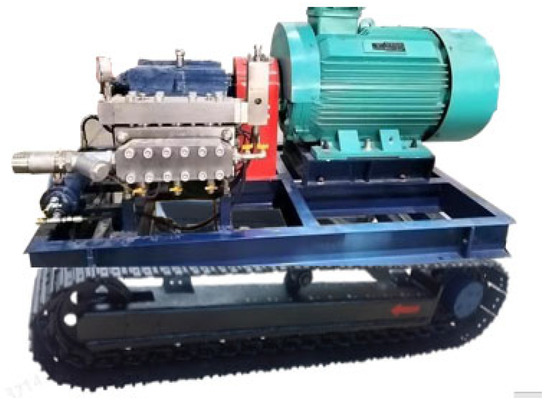
Figure 1.
Hydraulic measure power pump group.
2.2. Research on Packer Tool String Sealing Technology
The composition of fracturing hole sealing tool string, including lead shoe, packer, screen, sealing drill pipe, centralizer, and hole pressure retaining device, is shown in Figure 2. The packer can withstand a high pressure of 70 MPa, and has the characteristics of large expansion coefficient, reliable sealing, and reusable.
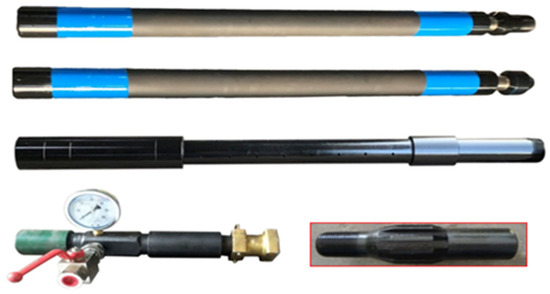
Figure 2.
The actual picture of the expansion stage fracturing tool string.
A simulation study was carried out on the length of the packer rubber bucket, and the force on the rubber bucket was calculated when the rubber bucket was 600 mm, 700 mm, 800 mm, and 900 mm. It was found that the maximum force was on the shoulder of the rubber bucket, and the shear resistance of the packer rubber bucket was the strongest when the size of the rubber bucket was 800 mm. See Figure 3, Figure 4, Figure 5 and Figure 6 for the optimal design length.
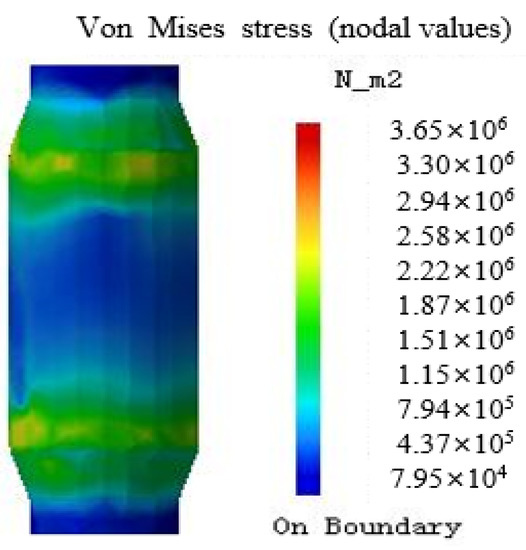
Figure 3.
Stress cloud diagram of 600 mm rubber barrel.
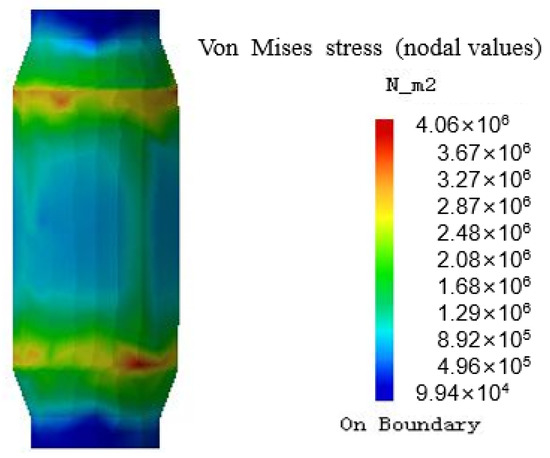
Figure 4.
Stress cloud diagram of 700 mm rubber barrel.

Figure 5.
Stress cloud diagram of 800 mm rubber barrel.
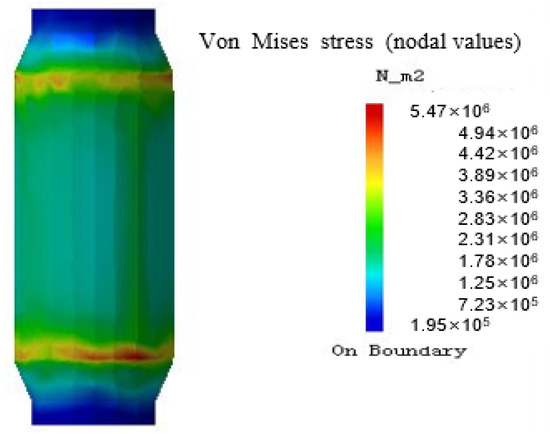
Figure 6.
Stress cloud diagram of 900 mm rubber barrel.
The packer hole sealing reliability experiment was carried out. The double packers were put into the sleeve and pressed between the two packers. When the pressure was 30 MPa and 60 MPa, respectively, the packer moved 2 cm and 5 cm (marked by red and blue chalk in the lower left figure), which verified the reliability of the packer setting. After being pressed, the shoulder wear of the packer was observed to be large. The numerical simulation results are in line with those shown in Figure 7.
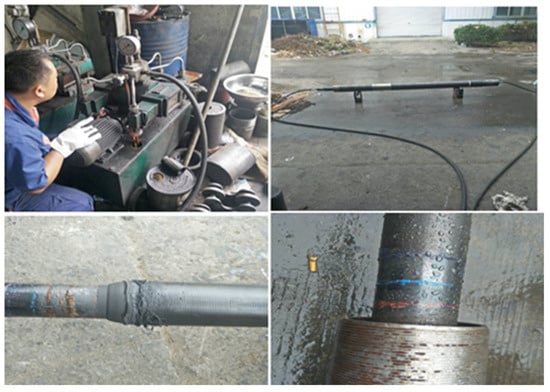
Figure 7.
Reliability test of inflatable fracturing packer.
2.3. Sealing Process of Hydraulic Fracturing Packer through Zone Drilling
(1) A single packer was used to lower the packer to the coal–rock interface, and the packer was inflated and set by high pressure water. The high-pressure water entered the borehole cavity through the screen tube to fracturing the coal seam. This process has the characteristics of short depth under packer and high construction efficiency. The disadvantage is that the sealing in soft coal is not reliable, the high-pressure water forms one-way thrust on the packer, and the tool string is easily affected by high-pressure water extrusion and external impact. See Figure 8 for the schematic diagram of the process.
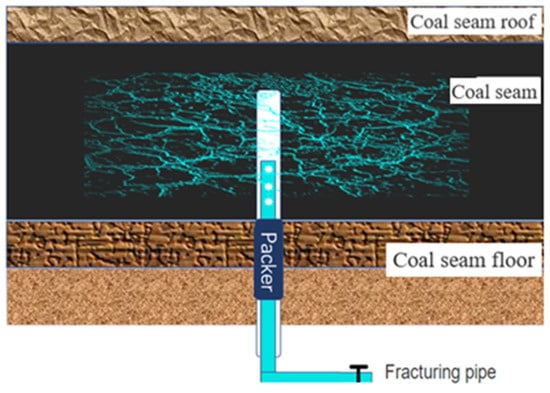
Figure 8.
Schematic diagram of sealing process of inflatable packer through zone drilling.
(2) In view of coal and rock geological conditions such as broken roof, fault distribution and soft structure, the fracturing technology of penetrating double packer is developed, as shown in Figure 9. The cross-type double packer cross-type fracturing tool string is developed to convert the one-way pressure of high-pressure water on the packer in the fractured interval into the internal tension of the packer. While meeting the requirements of perforating hydraulic fracturing, it also solves the problems of poor packer sealing effect and backwash of packer tool string in the hole.
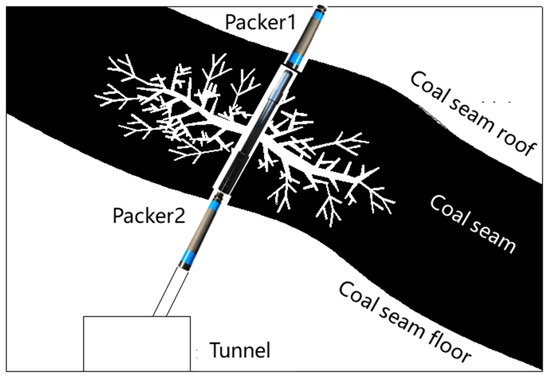
Figure 9.
Schematic diagram of double packer sealing process in perforating zone drilling.
During the fault, the thickness of the coal seam on the weak surface of coal rock changes greatly, the fracture direction is uncontrollable in areas such as igneous rock intrusion, and the fracturing fluid leaks easily, the double packer sealing process can realize the advantages of avoiding structure and precise fracturing.
The coal seam with fault structure can be hydraulically fractured with double packers. There is a frac zone between the two packers. The length of the frac zone can be adjusted by the number of pipe seals between the two packers. The frac tool string is shown in Figure 10. According to the drilling data, the structure position can be predicted, and the tool string of the double packer can be lowered to the preset position at the bottom of the hole to fracturing stage by stage from the inside out. Field tests have verified that the process of lowering, setting, unsealing, and driving the packer tool string is stable and reliable. See Figure 11.

Figure 10.
Physical connection diagram of double packer fracturing tool string.
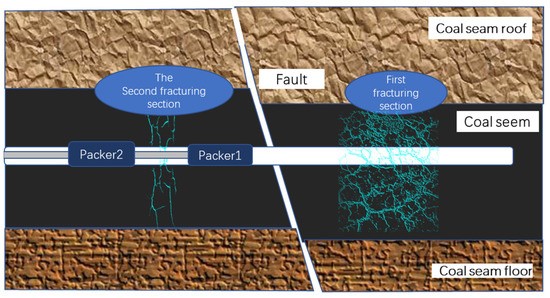
Figure 11.
Dual packer to avoid the structural stage fracturing.
3. Field Test of Fracturing Punching in Bottom Pumping Lane 14201
3.1. Site Selection of Hydraulic Pressure and Flushing Combined Permeability Test
- (a)
- In Henan province, gas extraction by floor roadway has been adopted as a regional measure, and hydraulic fracturing by drilling through floor roadway or hydraulic punching has been adopted to increase permeability and relieve pressure [32,33,34,35,36]. Yuan et al. aimed at the gas treatment problem in the strip pre-pumping area of low permeability and high permeability coal seam, applied the theory of elasticity, and combined with the characteristics of high-pressure hydrodynamics, proposed the anti-outburst technology of strip hydraulic fracturing of coal seam drilling through the layer, established the calculation model of target coal seam cracking pressure, and integrated supporting complete sets of downhole fracturing equipment [37]. Yu et al. carried out a study on the application of enhanced gas extraction and anti-outburst technology through strata drilling hydraulic fracturing [38]. Zhang et al. aimed at the anti-outburst technology of pre-pumping coal roadway gas strip area in single coal seam floor roadway through drilling [39].
- (b)
- At present, hydraulic fracturing is widely used in coal mines in the floor roadway penetration drilling; in penetration drilling fracturing for low permeability prominent coal seam, the anti-outburst effect is obvious, there is flexible drilling hole distribution, convenient drilling rig construction, and other advantages. However, there are also drawbacks such as large drilling quantities, intensive construction, and long pumping cycle. Therefore, it is of great practical significance to use hydraulic measures to strengthen gas extraction and realize permeability improvement of coal reservoir.
- (c)
- In this paper, with the use of fracturing and punching collaboratively, the pumping system will be high-pressure water into the coal seam to carry out fracturing anti-reflection communication coal seam, crack to the surrounding pressure relief intercepting hole, with the continuous pressure water into the hydraulic pressure punching stage, high-pressure water carrying coal slime from the surrounding intercepting hole discharge, to achieve further pressure relief and increase the permeability effect.
- (d)
- The Xinzheng Coal and Electricity Company is a coal and gas outburst mine, which is located in Xinzheng, Henan Province. The second coal seam is an outburst coal seam. The occurrence of gas in the second coal seam is high in the west and low in the east. With the increase of mining depth and the replacement of 14 mining areas, gas pressure and gas content increase, making it difficult to control gas during mining.
- (e)
- The Xinzheng Coal and Electricity Company is a coal and gas outburst mine, and the gas occurrence in the second coal seam of the mine field is high in the west and low in the east, which has the characteristics of soft top, soft bottom, and soft coal seam. The maximum gas pressure of coal seam is 0.45 MPa, the maximum gas content is 18.11 m3/t (located in the 14 mining area), the permeability coefficient of coal seam is 0.00092–0.178 m2/(MPa2·d). The firmness coefficient f of coal tested in the laboratory is 0.09–0.28, and the initial gas release velocity ΔP is 15.7–22.
- (f)
- The author selected the bottom pumping roadway on the 14201 working surface of Xinzheng Coal and Electricity as the test site, and used the bottom roadway to drill through the layer and rationally arranged the spacing of pressure crack hole and pressure relief intercepting hole to realize the combination of fracturing and punching two hydraulic measures to increase permeability and strengthen gas extraction. This demonstration project has an important reference significance for the permeability improvement of coal reservoir under similar coal seam conditions.
3.2. Implementation Plan of Perforating Hydraulic Fracturing and Punching
3.2.1. Fracturing and Interception Hole Layout in the Test Area
In the sequence of drilling layout, pressure relief and interception drilling holes should be arranged at the boundary of the control area before the construction of pressure crack holes, so as to control the control range of hydraulic fracturing and effectively prevent the late gas backflow caused by fracturing displacement. In the fracturing process, when the high-pressure water reaches the initiation pressure of coal seam, the fracture network begins to extend. With the fracture extension and gas driven away, the stress balance state of the original coal body and surrounding rock in the water injection area is broken, the stress is redistributed, and the stress concentration appears in a certain range of the coal body after fracturing. By optimizing the drilling layout and fracturing construction sequence, the effective penetration of the fracture network in the fracturing area and the control of the pressure relief space can be realized, so as to avoid the influence of stress concentration in the process of fracturing coal seam on the late mining work.
Intercepting boreholes are arranged at the strike and dip boundary of the control area of the test area, and the spacing between the intercepting boreholes and the adjacent fracturing holes is 20–30 m. The spacing of intercepting boreholes is 8–16 m. There are 78 intercepting boreholes designed and constructed 189 m in front of 14201 working surface upper and lower roadway pumping strip area.
One group of fracturing boreholes shall be arranged every 40–60 m along the strike of the coal roadway strip area of the upper roadway, and two fracturing boreholes shall be arranged at a distance of 20–30 m from both sides of the strip and a hole spacing of about 40 m. Eight fracturing boreholes are arranged in the upper roadway strip test area. The design of fracturing and intercepting boreholes in the test area is shown in Figure 12.
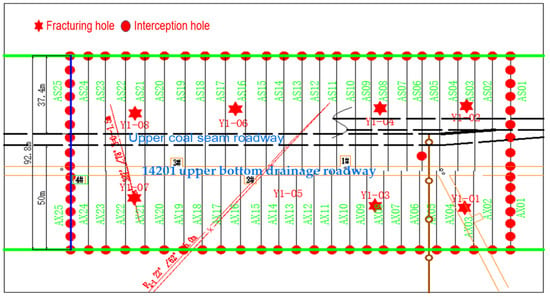
Figure 12.
Fracturing drilling design plan of 14201 working surface strip upper roadway test area.
3.2.2. Through Fracturing–Punching Enhanced Permeability Technology in the Test Area
Hydraulic fracturing destroys coal body by water pressure and forms a fissure network. It is widely used in increasing the permeability of coal seam, but the fracturing effect is also different. Especially in soft coal, to carry out fracturing, due to low firmness coefficient, plastic characteristics, and low strength, permeability is lower than hard coal, as well as crack development and connectivity; these characteristics determine that soft coal in hydraulic fracturing increases permeability. It is difficult to form a high permeability of the main crack, based on the elastic characteristics of the coal reservoir applied to hard coal seam which has good applicability. Soft coal is mainly characterized by plastic deformation, and its crack initiation and permeability increase rules have obvious differences, so it is difficult to guarantee the effect of hydraulic fracturing solely for soft coal conditions.
In this test, the coal seam is injected with water through the fracturing hole, and the fracturing is carried out in the area between the fracturing hole and the coal unloading hole. When the fracture penetrates to the coal unloading hole, the coal and gas will be emitted from the coal unloading hole and enter the tee of the coal unloading hole, the gas will be pumped into the low negative pressure drainage system, and the coal slime is stored in the coal storage tank, thus forming a “U”-shaped channel between the fracturing hole and the coal unloading hole. The flushing coal unloading at the coal unloading hole is realized by injecting water into the fracturing hole. When the designed coal unloading volume is reached, the gate valve at the coal unloading hole orifice is closed. After the pressure is suppressed, the high-pressure water is driven to other coal unloading holes. After the connection, the flushing coal unloading is continued until the coal unloading holes near the fracturing hole are completed. The soft coal layer multi drill hole through fracturing flushing method can effectively achieve both large-scale permeability increase through fracturing and linkage permeability increase and pressure relief through flushing of coal unloading hole. The process diagram is shown in Figure 13.
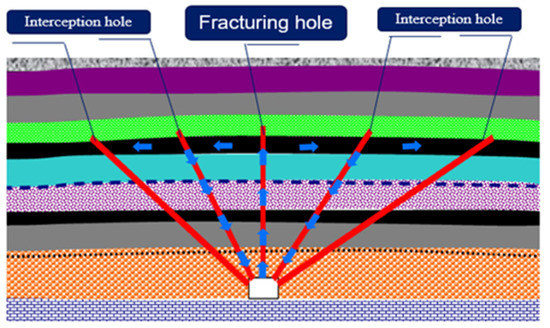
Figure 13.
Schematic diagram of fracturing flushing permeability enhancement of fracturing holes and intercepting holes.
3.2.3. Hole Sealing Scheme of Crack Pressure and Interception Hole in the Test Area
- (1)
- Pressure hole sealing process scheme
Packer down: This time, the packer quick hole sealing tool string was used to seal the fracture stage with double packers. The simple tool combination is conducive to reducing the hole accidents. The packer is dilated using high-pressure water to drive the packer to swell and seal the capsule in full contact with the hole wall. The packer is suitable for open hole setting and is relieved using pressure relief. The specific process of tool string lowering is shown in Figure 14.
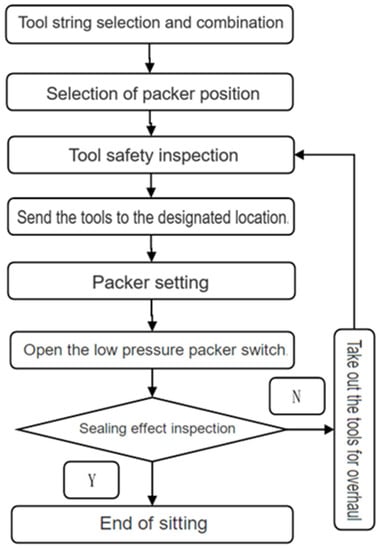
Figure 14.
Packer running and setting hole sealing flow chart.
- (2)
- Interception hole sealing process plan
Intercepting drilling adopts the “one block and two injection flexible sealing” mode in the whole rock hole section. The coal seam section is drilled with screen pipe, and the remaining part is sealed with solid pipe. A seamless steel pipe with a wall thickness of 4 mm is adopted.
The specific hole sealing process is as follows:
- (a)
- Lower the screen pipe and water injection steel pipe. The screen with the plug is placed in front of the fracturing steel pipe and lowered more than 2/3 of the depth of the coal hole. Ensure a high-pressure seal between the fractured pipe and between the screens.
- (b)
- Fix the cotton yarn and woven bag on the fractured steel pipe at the lower end of the screen tube (specification: 45# steel, 25 mm) for flexible sealing. The cotton yarn and woven bag are lowered to 1–2 m above the coal–rock junction of the coal seam floor, and the bunched regrouting pipe is lowered at the same time. The regrouting pipe (4 decimeter tube) exceeds the coal seam floor by 0.5–1 m, and a 6 m long grouting pipe (4 decimeter tube) is lowered to the orifice. After the pipe is placed, the sealing bag at the external hole is placed at 0.5 m away from the hole.
- (c)
- Grouting hole sealing. The hole sealing material shall be the hole sealing cement with the mark of 425 or above and the “U”-type expansion agent, which shall be proportioned as 1:1 (or the finished grouting material that has been proportioned) and mixed evenly. After the pipeline is placed, the slurry pump is used to continuously inject the cement slurry into the borehole through the grouting pipe at one time, and the orifice valve of the slurry return pipe is opened. When it is estimated that the injected cement slurry will soon reach the position of the sieve tube, technicians or senior skilled workers should observe and measure whether there is cement slurry reflux at the mouth of the slurry return tube. If the slurry return is successful, immediately turn off the power supply of the grouting pump, and the grouting of this hole is completed. After that, immediately close the ball valve of the grouting pipe, dismantle the high-pressure grouting pipe, connect the rubber pipe used for grouting to the return pipe, open the orifice valve of the return pipe, flush the cement slurry in the return pipe and the fracturing steel pipe with clean water, stop the pump after cleaning for 5–10 min, dismantle the rubber pipe used for grouting, and keep the orifice valve of the return pipe open. After the cement slurry is solidified for 16 h, inject the cement slurry into the fracturing hole through the slurry return pipe. After the slurry return of the seamless steel pipe, stop injecting the cement slurry, close the orifice valve of the slurry return pipe, and complete the interception and borehole sealing. After the completion of borehole sealing, observe whether there is gas at the orifice of the fracturing pipe to judge and ensure that the intercepting hole is unobstructed. See Figure 15 for the schematic diagram of hole sealing.
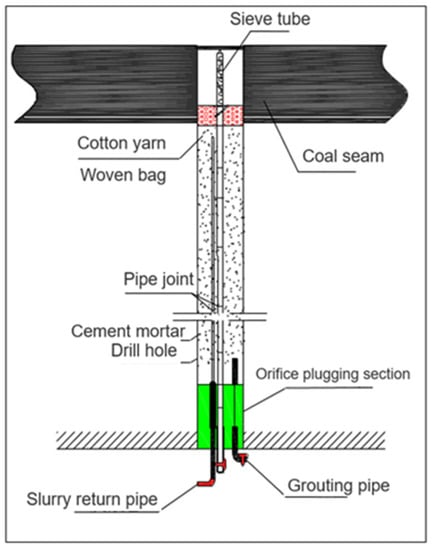 Figure 15. Intercepting hole block two injection flexible sealing process diagram.
Figure 15. Intercepting hole block two injection flexible sealing process diagram.
The effective range of fracturing and the end of fracturing are determined by examining the water discharge of the fracturing hole on both sides of the fracturing hole. In order to ensure fracturing safety, the spacing between pressure holes in the test area should be designed at the maximum 20 m, and water from the holes on both sides of the pressure hole should be investigated to ensure that the effective fracturing radius reaches 10 m. Drag-type subsection fracturing to each drag to a fracturing drilling section must ensure that the water is out of the inspection hole, to ensure the effectiveness of fracturing in different drilling sections.
4. Analysis of Fracturing Effect
4.1. Fracturing Test Results
The preparation for fracturing equipment commissioning in the upper roadway test area of 14201 working face was completed on 15 September 2021. The fracturing start time was 8:00 on 17 September, and the fracturing end time was 8:00 on 30 September. The construction period was 12 days. Before each fracturing, it was checked whether the fracturing hole and the interceptor hole were abnormal. The camera was aimed at the fracturing hole and the nearest interceptor hole, and fracturing started after warning and inspection.
The video monitor verifies that a large amount of slime is ejected from the intercepting hole, indicating that the hydraulic fracture extends from the fracturing hole to the pressure relief intercepting hole. After the black water and slime are discharged from the intercepting hole near the fracturing hole, the orifice valve of the intercepting hole was closed, so that the high-pressure water-induced crack continued to expand in the direction of other intercepting holes. See Figure 16 for the coal slurry emission from the intercepting hole.
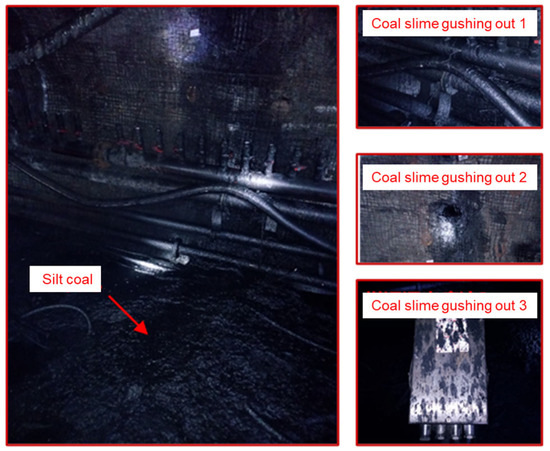
Figure 16.
Site picture of coal slime gushing from interception hole punching.
The total injection water of the eight pressure holes is up to 1037 m3. The arrow points to the position of coal water from the interception hole punching, and the oval marks represent the measured orifice gas concentration after fracturing, as shown in Figure 17.
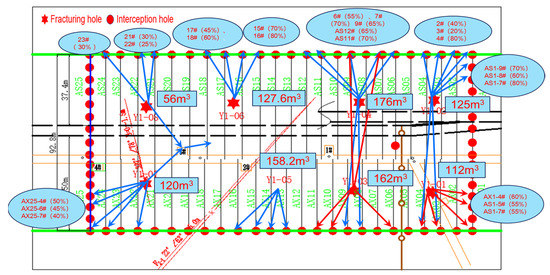
Figure 17.
Water discharge from interceptor holes and gas concentration at orifice.
4.2. Comparison of Extraction Effect between Test Area and Non-Test Area
After fracturing and punching measures were carried out in the test area, extraction holes were constructed, and single-hole extraction data (measured by YZC5 of Chongqing Institute) of three groups (6 groups, 9 groups, 13 groups) were analyzed. Group 6: the average single hole concentration was 23.3%, and the daily net volume of single hole pumping was 38.5 m3; Group 9: the average single hole concentration was 33.7%, and the daily net volume of single hole pumping was 41.9 m3; Group 13: the average single hole concentration was 14.6%, and the daily net volume of single hole pumping was 20.6 m3. From the analysis of the relative position with the pressure hole, the gas concentration and daily extraction volume of the single hole in Group 9 were obviously higher near the 3# and 4# pressure hole, and it was preliminary judged that the closer the gas concentration is to the pressure hole, the better the permeability enhancement effect is. The position of Group 6 was between the Group 1–2 pressure hole and the Group 3–4 pressure hole, and the permeability enhancement effect was worse than that in Group 9, and the gas content in the extraction hole area of Group 13 was smaller than that in the outer section. Moreover, it had structural influence, and the drainage effect was not as good as that of Group 6 and Group 9, as shown in Figure 18.

Figure 18.
Relative positions of the three groups of extraction holes in the test area.
The test area was the first extraction unit, with the maximum gas content of 8.89 m3/t, which was fractured and punched. The second extraction unit was the area to be fractured. The strike and dip boundaries of the strip control area were equipped with intercepting boreholes, and the spacing between the intercepting boreholes and the adjacent pressure holes was 20–30 m. The interception hole spacing was 8–16 m, and the maximum gas content was 8.09 m3/t. The data of orifice pumping in the two units from 10 January to 26 January 2022 were calculated. The average concentration of boreholes in the first extraction unit was 4.8 times that of the second extraction unit, as shown in Figure 19. The average 100-hole pure volume in the fractured area was 42 times that in the unfractured area. See Figure 20. The fracturing of the second unit started on 17 January 2022. As can be seen from Figure 19 and Figure 20, the concentration and purity of the two extraction units increased significantly during the second unit fracturing due to fracturing disturbances.
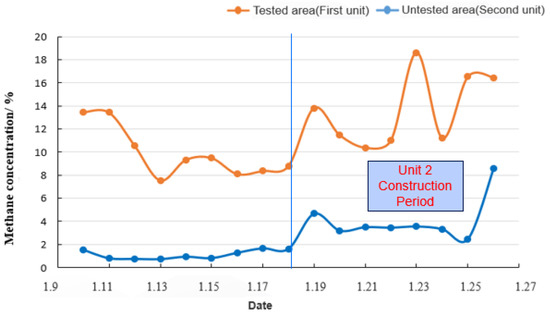
Figure 19.
Concentration comparison curve between fracturing flushing area and untested area.
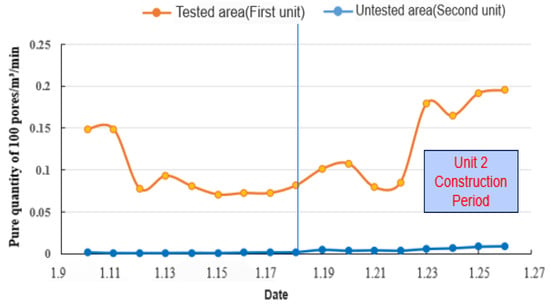
Figure 20.
The 100-hole purity comparison curve between fractured area and unfractured area.
5. Conclusions
(1) Research was carried out on the perforating drilling hydraulic fracturing packer sealing process. The reliability of packer sealing was verified through ground experiments and numerical analog verification. After pressurization, the shoulder wear of the packer was relatively large, which is consistent with the results of numerical simulation. On this basis, the formation penetrating single packer integral fracturing and straddle dual packer integral fracturing and hole sealing processes were adopted, and the lowering, setting, unsealing, dragging, and recovery were smooth, realizing rapid plugging, effectively avoiding faults, and meeting the requirements of precise fracturing.
(2) The research on soft coal hydraulic fracturing flushing and permeability enhancement technology by packer tool string sealing was carried out. The high-pressure water trigger made the straddle front and rear double packers expand and set, sealed the fractured coal seam section, and then carried out fracturing and permeability enhancement. After communicating with the surrounding pressure relief interceptor holes, with the continuous pressure of high-pressure water, it entered the hydraulic pressure flushing stage, and the high-pressure water carried the coal slime discharged from the surrounding interceptor holes to realize further pressure relief, capacity, and permeability enhancement.
The combined high-pressure fracking and punching technology will achieve the dual effect of pressure relief and permeability enhancement within the influence range of the extracted coal seam, thus greatly improving the permeability coefficient of the original coal seam, thereby significantly improving the efficiency of gas extraction, and greatly shortening the time for gas extraction to meet the standard.
(3) The hydraulic pressure flushing test was carried out in the upper and bottom drainage roadway of 14201 working face in Xinzheng Coal and Electricity Company, and the reliability of the process was verified. Compared with the gas drainage effect in the pressure flushing area and the non-pressure flushing area, the average concentration in the test area was 4.8 times that in the test area (without fracturing), and the average 100-hole purity test area was 42 times that in the non-test area. During the hydraulic flushing period in the test area, the pressure crack disturbance has an obvious impact on the concentration and purity of the test area and adjacent test areas. This test verifies that the fracturing plays a synergistic role in increasing permeability and pressure relief by flushing the interceptor hole while connecting the fractures in a large range.
Author Contributions
Conceptualization, Z.Y.; methodology, Z.Y., Z.Z. and L.D.; validation, Z.Y., Z.Z. and L.D.; formal analysis, Z.Y.; investigation, L.D.; resources, Z.Y.; data curation, Z.Y. and L.D.; writing—original draft preparation, Z.Y., Z.Z. and L.D.; writing—review and editing, Z.Y., Z.Z. and L.D.; visualization, Z.Y. and L.D.; supervision, Z.Z. and L.D.; project administration, Z.Y., Z.Z. and L.D.; funding acquisition, Z.Y. and L.D. All authors have read and agreed to the published version of the manuscript.
Funding
This research was funded by Technological Innovation and Entrepreneurship Fund Special Project of Tiandi Technology Co., Ltd. (No. 2022-2-TD-ZD008), National Natural Science Foundation of China (No. 51874348), Natural Science Foundation of Chongqing (No. CSTB2022NSCQ-MSX1080).
Institutional Review Board Statement
The study did not require ethical approval.
Informed Consent Statement
Informed consent was obtained from all subjects involved in the study.
Data Availability Statement
All data and/or models used in the study appear in the submitted article.
Conflicts of Interest
The authors declare no conflict of interest.
References
- Wang, C.H.; Cheng, Y.P. Role of coal deformation energy in coal and gas outburst: A review. Fuel 2023, 332, 126019. [Google Scholar] [CrossRef]
- Dai, L.C.; Liu, Y.B.; Cao, J. A study on the energy condition and quantitative analysis of the occurrence of a coal and gas outburst. Shock. Vib. 2019, 2019, 8651353. [Google Scholar] [CrossRef]
- Hou, J.X.; Zhang, Y.G.; Zhang, J.C. Multiple statistical comparison of the micropore structures between the tectonically deformed and undeformed coal particles and cause analysis of the difference. J. Saf. Environ. 2018, 18, 139–146. [Google Scholar]
- Lei, W.J.; Liu, X.F. Gas flowing features of hard and soft coal seems under the 3D compression stress. J. Saf. Environ. 2018, 18, 156–160. [Google Scholar]
- Xu, C.P.; Li, H.; Lu, Y. Research status of borehole instability characteristics and control technology for gas extraction in soft coal seam. Min. Saf. Environ. Prot. 2022, 49, 131–135. [Google Scholar]
- Zhao, Z.G.; Li, C.S.; Ying, C.J. Mechanical characteristics of soft coal, hard coal, mudstone gangue and their significance in gas geology. Mine Constr. Technol. 2016, 37, 1–4. [Google Scholar]
- Lv, Y.C. Application the hydraulic fracturing technology in the high pressure and low permeability mine. J. Chongqing Univ. 2010, 33, 102–108. [Google Scholar]
- Li, B.; Song, Z.M.; Ren, J.G. Gas migration mechanism of hydraulic fracturing on soft coal roof. J. Liaoning Tech. Univ. Nat. Sci. 2014, 33, 317–320. [Google Scholar]
- Sun, B.X.; Wang, Z.F.; Wu, H.R. Hydraulic pressurized cracking and permeability improvement technology applied to gas drainage. Coal Sci. Technol. 2010, 38, 78–80+119. [Google Scholar]
- Ma, Y.K.; Mao, X.Y.; Yang, K.; Liu, J.; Zhao, A.H. Improvement on gas drainage of soft gassy coal seam with underground hydraulic flushing and fracturing: A case study in Huainan. Arab. J. Geosci. 2020, 13, 178. [Google Scholar] [CrossRef]
- Zhai, C.; Li, X.Z.; Li, Q.G. Research and application of coal seam pulse hydraulic fracturing technology. J. China Coal Soc. 2011, 36, 1996–2001. [Google Scholar]
- Li, D.Q.; Chen, Y.B.; Zhang, J.B.; Wang, M.Z. Research and application of pressure relief and permeability improvement in high gas outburst mines by directional drilling and hydraulic jet. Front. Earth Sci. 2023, 10, 1029429. [Google Scholar] [CrossRef]
- Zhang, X.Z.; Wisniewski, P.; Dykas, S.; Zhang, G.J. Permeability enhancement properties of high-pressure abrasive water jet flushing and its application in a soft coal seam. Front. Energy Res. 2021, 9, 679623. [Google Scholar] [CrossRef]
- Ge, Z.L.; Mei, X.D.; Lu, Y.Y.; Cheng, L.; Xia, B.W.; Chen, J.F. Drilling sealed parameters and optimization of a new type sealing material for hydraulic fracturing in underground coalmines. J. Basic Sci. Eng. 2014, 22, 1128–1139. [Google Scholar]
- Wen, G.J.; Wu, X.M.; Wang, S.W.; Liu, Y.L.; Niu, H.L.; Liu, J.; Shao, M.L. Design and experiment of downhole hydraulic packer for coalbed methane subhorizontal drilling. Coal Geol. Explor. 2008, 36, 73–77. [Google Scholar]
- Qu, C.F.; Zhang, Y.Q.; Wang, Z.H. Application of swelling packer in coalbed methane wells in Australia. Oil Drill. Prod. Technol. 2014, 36, 119–121. [Google Scholar]
- Zhang, F.W.; Guo, C.Y.; Zhuo, Z.Q. Research on capsule packer plugging technology of coal mine downhole pressure hole. Min. Saf. Environ. Prot. 2012, 39, 9–12. [Google Scholar]
- Liu, M.J.; Kong, L.A.; Hao, F.C. Application of hydraulic punching technology in severely protruding coal seam. J. China Coal Soc. 2005, 04, 451–454. [Google Scholar]
- Chen, Y.; Li, D.; Wang, S. Study on Mechanism of Pressure Relief and Permeability Enhancement in Soft-hard Composite Coal Seam by Directional Hydraulic Flushing Technology. Acta Montan. Slovaca 2022, 27, 522–536. [Google Scholar]
- Ren, P.L.; Liu, Y.W.; Han, H.K. Study on influence laws of coal flushing rate on coal seam stress relief and gas extraction. Coal Sci. Technol. 2022, 50, 102–109. [Google Scholar]
- Ma, G.; Liu, X.; Li, F. Study on morphology features of hydraulic flushing hole based on ore drawing theory. Coal Sci. Technol. 2016, 44, 73–77. [Google Scholar]
- Feng, W.J.; Su, X.B.; Wang, J.W. The mechanism and field test of permeability improvement by hydraulic flushing in three-soft and single coal seam. Coal Geol. Explor. 2015, 43, 100–103. [Google Scholar]
- Zhang, H.; Cheng, Y.; Deng, C. A novel in-seam borehole discontinuous hydraulic flushing technology in the driving face of soft coal seams: Enhanced gas extraction mechanism and field application. Rock Mech. Rock Eng. 2022, 55, 885–907. [Google Scholar] [CrossRef]
- Zhang, R.; Hao, C. Research on the development of hydraulic flushing caverning technology and equipment for gas extraction in soft and low permeability tectonic coal seams in China. ACS Omega 2022, 7, 21615–21623. [Google Scholar] [CrossRef] [PubMed]
- Liu, X.; Li, Y.; Xuan, D.Q. Numerical simulation and test of Layered water jet gas extraction in soft coal sandwich with pressure relief and permeability improvement. Coal Geol. Explor. 2021, 49, 54–61. [Google Scholar]
- Tang, Y.Z.; Li, P.; Zhu, G.W. Application of ultra-high pressure hydraulic slotting technology in medium hardness and low permeability coal seam. Coal Sci. Technol. 2022, 50, 43–49. [Google Scholar]
- Lin, B.Q.; Li, Z.W.; Zhai, C. Pressure relief and permeability-increasing technology based on high pressure pulsating hydraulic fracturing and its application. J. Min. Saf. Eng. 2011, 28, 452–455. [Google Scholar]
- He, Q.Y.; Zhu, L.; Li, Y.C.; Li, D.Q.; Zhang, B.Y. Simulating hydraulic fracture re-orientation in heterogeneous rocks with an improved discrete element method. Rock Mech. Rock Eng. 2021, 54, 2859–2879. [Google Scholar] [CrossRef]
- Su, X.B.; Song, J.X.; Guo, H.Y. Increasing production mechanism and key technology of gas extraction in coal mines. Coal Sci. Technol. 2020, 48, 1–30. [Google Scholar]
- Qin, J.T.; Chen, Y.T. Research and application of combined antireflection technology of high pressure hydraulic fracturing and punching in low permeability coal seam. Min. Saf. Environ. Prot. 2021, 48, 53–57. [Google Scholar]
- Xu, T.; Feng, W.J.; Su, X.B. Experimental research on enhanced gas extraction application with hydraulic fracturing and flushing. J. Xi’an Univ. Sci. Technol. 2015, 35, 303–306+312. [Google Scholar]
- Jiang, J.H. New method of improving gas releasing rate from weak seepage seam. Coal 2000, 2, 9–12. [Google Scholar]
- Zhang, G.H.; Wei, G.P. Theory of start-split affusion stress and start-split location about through coal delaminaions’ bore of hydraulic fracture. J. China Coal Soc. 2007, 32, 52–55. [Google Scholar]
- Xu, R. Research and application of hydraulic fracturing technology for strip gas treatment in comb borehole in inclined and soft coal seam. Coal Technol. 2021, 40, 106–109. [Google Scholar]
- Xiao, C.H.; Wang, C.G. Numerical simulation of pressure relief and reflection improvement effect of hydraulic punching in protruding coal seam. Coal Technol. 2015, 34, 147–149. [Google Scholar]
- Hao, F.C.; Sun, L.J.; Liu, M.J. Research on boreholes space optimization of hydraulic flushing considering press relief and gas drainage effect. J. Min. Saf. Eng. 2014, 31, 756–763. [Google Scholar]
- Yuan, Z.G.; Ren, M.Q.; Shen, Y.H. Anti-surge technology and application of hydraulic fracturing in coal roadway with perforated borehole. J. Chongqing Univ. 2016, 39, 72–78. [Google Scholar]
- Yu, T.; Lu, M.; Zhu, G.W. Study on enhanced gas drainage by hydraulic fracture in cross-measure boreholes. J. Saf. Environ. 2010, 10, 172–175. [Google Scholar]
- Zhang, M.J.; Hua, J.J.; Hua, J.T. Outburst prevention technology in gas strip area of single coal seam floor roadway through layer drilling and pre-extraction coal roadway. Saf. Coal Mines 2011, 42, 30–32. [Google Scholar]
Disclaimer/Publisher’s Note: The statements, opinions and data contained in all publications are solely those of the individual author(s) and contributor(s) and not of MDPI and/or the editor(s). MDPI and/or the editor(s) disclaim responsibility for any injury to people or property resulting from any ideas, methods, instructions or products referred to in the content. |
© 2023 by the authors. Licensee MDPI, Basel, Switzerland. This article is an open access article distributed under the terms and conditions of the Creative Commons Attribution (CC BY) license (https://creativecommons.org/licenses/by/4.0/).